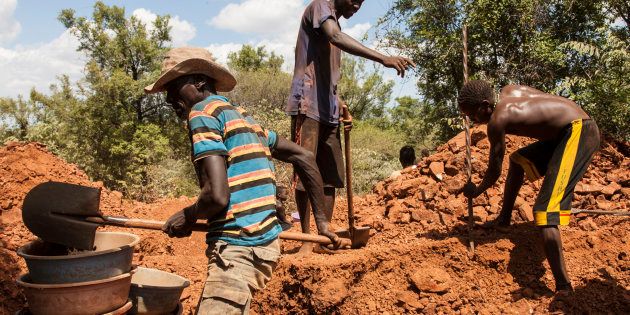
Reports around the disregard for human and labour rights in the production of smartphones and other digital technology have been rife for years. Many of the components used in our devices are reportedly sourced through child labour and inhumane working conditions. The high value of these minerals has also fuelled competition, resulting in conflict involving mass killings and rape as a weapon of war.
- Read our special report: Stop The Cycle
All of us who own a PC, phone or other electronic gadget enjoy the benefits of new technologies, but rarely do we spare a thought as to how they are made. Inside many of these electronic devices are components that began life as minerals dug underground, sometimes at a great cost of human dignity.
Miners in countries such as Myanmar, Bolivia, Rwanda and the Democratic Republic of Congo (DRC) use children as young as seven who work in perilous conditions, scavenging for minerals in industrial mines and washing and sorting them before they are sold. The minerals travel through a chain of suppliers through Asia and elsewhere to be smelted into metals, and then onto the world at large where they end up in electronics, as well in vehicles and jewelry.
"The glamorous shop displays and marketing of state of the art technologies are a stark contrast to the children carrying bags of rocks, and miners in narrow manmade tunnels risking permanent lung damage,"Mark Dummett, Business & Human Rights Researcher at Amnesty International
The DRC is home to the deadliest conflict since World War II — in large part because of the international demand for electronic technologies such as smartphones, laptops and the like, that requires minerals found in the land. While the on-going conflict in eastern Congo is a complex crisis involving issues such as tensions over land, rights, and identity, the trade in conflict minerals is one of the most pressing issues and drivers of the conflict. Competition over "conflict resources" — natural resources extracted in a conflict zone and sold to perpetuate the fighting — has fuelled two decades of conflict in its eastern provinces, including a 1998 to 2003 war that killed more than 5.4 million people.
Armed groups in the DRC trade in gold and the 3Ts- tin, tantalum and tungsten. The DRC produces an estimated six to eight percent of the world's tin, making it the sixth largest producer. In 2015, Tech Republic published an in-depth investigation into the devastating reality of the working conditions of a mine in the Walikale region of the DRC, controlled by the armed militia.
Axel Mutia Mburano, a miner in the Walikale region of the DRC told Tech Republic:
Sometimes people worked 24 hours out of 24, night and day, using head-mounted lamps — one team working days and one doing nights. At the time there were no rules, and sometimes miners died of fatigue. There were also deaths because the pits were deep and there was flooding...We were in a really isolated quarry that made transporting the minerals to the Walikale distribution centre very hard.... It was more than 50-km away, so the minerals had to be carried on men's backs — and even women and children were used, too...The armed groups saw themselves as being outside the law, so there were a lot of thefts and sometimes rapes because no one could control them.
While much attention has been given to the working conditions of mines in eastern Congo because of the devastating war in the region, human rights bodies such asAmnesty International and Afrewatch have drawn attention to the reality that the mining conditions in other parts of the DRC that supply minerals used in technologies, are no less heartbreaking than that of the war zone.
In an investigative report co-published by Amnesty International and Afrewatch in 2016, it was reported that approximately 40,000 children worked in mines across Southern DRC, and that some children worked for up to 12 hours a day while others spent their entire days on the mines, earning between 1,000-2,000 Congolese francs per day – the equivalent of between one and two US dollars a day, or about R14,00-R28,00 in South African terms. A 14-year-old orphan and cobalt miner in southern DRC told Amnesty International:
I would spend 24 hours down in the tunnels. I arrived in the morning and would leave the following morning.
More than half of the world's total supply of cobalt, a key component in lithium-ion rechargeable batteries -- the most common type of battery for portable electronics such as smartphones and laptops -- come from the DRC, and more than 20 percent of the cobalt exported from the DRC comes from small-scale miners in the southern part of the country.
For a long time, electronic firms claimed that determining whether their products were perpetuating a cycle of killings and rape in the DRCwas a near impossible task — both financially and logistically, but in recent years, many brands have begun cleaning up their act making significant strides in progress, which is in large part owing to legal pressure.
Since 2010, the DRC's supply of metals used in smartphones, batteries and laptops has been under scrutiny after US laws required all US-listed firms to ensure supply chains were free from "conflict minerals". Most US-registered computer component and PC manufacturers are now attempting to document their supply chains and remove conflict minerals via the Conflict-Free Smelter Program (CFSP). The programme is run by the Electronic Industry Citizenship Coalition, an electronics industry body that works to make supply chains more socially, environmentally, and economically friendly, and the Global e-Sustainability Initiative (GeSI). More than 120 companies are participating in the CFSP, including electronic giants Dell, HP, Intel, Microsoft, Nokia, and Apple.
To date, more than 70 smelters have been listed as conflict-free under the CFSP, providing computer makers with a source of metals that isn't perpetuating abuses by armed groups in central Africa. However, according to Tech Republic, there simply aren't enough of these conflict-free smelters to meet the needs of the world's biggest computer makers. HP, the world's largest server maker which was also rated as having made the second most progress of any electronics manufacturer in the world by the Enough Project in 2012, said that of the just over 200 smelters it deals with only about 60 are certified as conflict-free. In 2014, Apple revealed similar figures, verifying 59 smelters in its supply chain as conflict-free, but 104 of its smelters use minerals whose origins are unknown.
It is a major paradox of the digital era that some of the world's richest, most innovative companies are able to market incredibly sophisticated devices without being required to show where they source raw materials for their componentsAfrewatch Executive Director Emmanuel Umpula
While there is little that we can do to change how consumer products are manufactured, we can however make informed choices based on progress reports issued by our favourite brands, as well as on ethical consumerism guides such as those from the Ethical Consumer or The Good Shopping Guide, and see where different phones, laptops and the like, rank. Consumers are also encouraged to repair and reuse products rather than throw them away.
